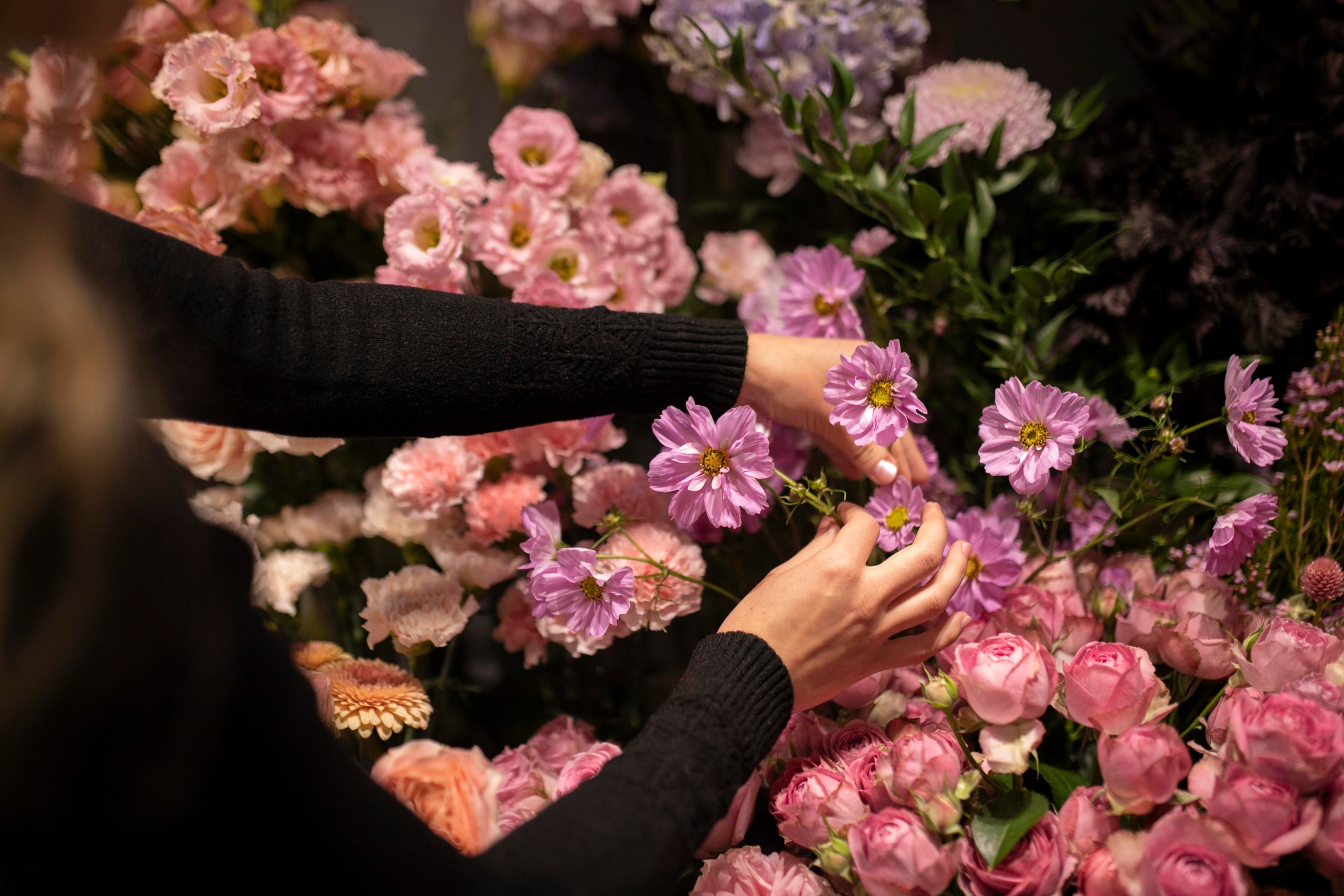Opening a flower shop is a dream for many floral enthusiasts, as it allows you to blend creativity with business acumen. A flower shop business is a wonderful opportunity to connect with your local community, brighten up special occasions, and make a living from your passion for floral design. With the right approach, you can establish a successful flower shop that attracts customers, grows steadily, and becomes a cornerstone of the local businesses in your area. This article will walk you through the necessary steps to setting up your flower shop, from choosing the right business model to launching your beautiful floral store. Eager to initiate your own floral venture? This guide provides the essential strategies and insights needed to open a thriving flower shop.
Boost customer satisfaction with just a few clicks
Most-Loved Features:
- On-demand drivers
- Real-time GPS tracking
- Delivery confirmation photos
- Over 50% of customers report a smoother delivery experience
Why Start a Floral Business?
Starting a floral business offers numerous rewards. For one, the flower industry is known for its consistent demand, driven by year-round events like weddings, holidays, and corporate functions. Small business owners who have a passion for floral design can tap into this demand to create stunning arrangements that keep customers coming back. Additionally, the flexibility of running a flower shop business allows you to operate as a local florist shop, an online flower shop, or a hybrid model that offers both retail and online flower delivery services. By building a strong reputation in your community and partnering with other local businesses, you can create a successful flower shop that becomes well-loved in your area. Are you eager to initiate your own floral enterprise, leveraging your love for floral design to meet the constant market demand? This guide is packed with insider insights on how to kickstart a flourishing flower shop business effectively.
Metrobi is transforming flower deliveries
Specialized solutions for flower businesses:
- Flower-trained drivers
- Proper handling equipment
- Peak day delivery support
- 23% average cost reduction
Steps to Setting Up Your Flower Shop in 9 Simple Steps

1. Pick the Right Business Model
Choosing the right business model is the first, and perhaps the most important, decision you’ll make when starting your flower business. The model you select will shape everything from your initial investments to your marketing strategy and customer engagement.
Brick-and-Mortar Flower Shop: This traditional model involves setting up a physical location where customers can walk in, browse your floral arrangements, and purchase directly from your store. This option is ideal for local businesses aiming to become a community staple. You can create a warm, inviting space that reflects your brand and provides exceptional customer service. Consider offering in-store consultations for weddings, corporate events, and special occasions to attract repeat customers.
Online Flower Shop: If you’re more inclined to manage a digital storefront, an online flower business allows you to offer floral arrangements and delivery services without the overhead costs of maintaining a physical store. With the growing demand for online shopping, this model helps you tap into a wider target market beyond just local customers. You can create an easy-to-navigate eCommerce website that highlights your products and offers a variety of delivery options, from same-day services to scheduled deliveries for special events.
Hybrid Model: Combining both a retail flower shop and an online flower delivery service allows you to reach both local walk-in customers and a broader online audience. This hybrid approach can be highly effective, as it offers the personal touch of a local florist shop with the convenience of online shopping.
Deciding on the right business model also means considering how you’ll handle delivery services. Same-day delivery, especially for last-minute floral gifts, is a popular option, but it requires reliable transportation and logistics. Will you partner with a local delivery service, or will you handle deliveries in-house? Offering both in-store pick-up and delivery services can give your customers flexibility, making your flower business more attractive.

2. Conduct In-Depth Market Research
Conducting thorough market research is critical to ensuring the success of your floral business. It helps you understand your competition, target customers, and the overall landscape of the flower industry in your area. Start by researching existing florists, both brick-and-mortar shops and online flower shops, to understand what they offer and how they engage with their customers. Look at how they position their business, their pricing strategies, and what makes them stand out. Discover how selecting the right location for your florist shop can significantly impact your business’s visibility and appeal to potential customers.
Additionally, ensure you partner with a reliable delivery service to enhance your flower shop’s logistics. A dependable floral delivery service will guarantee that your floral arrangements arrive fresh and on time, ultimately boosting customer satisfaction and loyalty.
Next, analyze customer behavior and preferences. Are there many local florists offering floral arrangements for weddings and corporate events, or is there an underserved market for special occasions like birthdays and anniversaries? Explore potential partnerships with other local businesses such as event planners, gift shops, and wedding venues. Understanding your customers’ buying habits, such as whether they prefer purchasing flowers from grocery stores, local flower shops, or online platforms, will guide you in crafting a business strategy that resonates with your target audience. One crucial aspect of crafting a successful flower business strategy is selecting the right delivery services. A reliable delivery option can greatly enhance customer satisfaction; therefore, it’s beneficial to partner with a trustworthy courier service. For businesses in the Miami area, finding a punctual and efficient courier service in Miami can be a game-changer, ensuring that your floral arrangements arrive fresh and timely.
Market research should also cover seasonal trends in the flower industry. Floral sales tend to peak during specific holidays like Valentine’s Day, Mother’s Day, and the wedding season. By understanding these trends, you can stock up on the most popular flowers during these times and plan promotions or events to attract customers. This research will help you create a business strategy that not only meets current market demands but also positions your flower shop as a leader in your local community.

3. Develop a Detailed Business Plan
A comprehensive business plan is essential to your flower shop’s success. Your plan should outline the key aspects of your business, including your mission, goals, target market, competitive analysis, and financial projections. Consider incorporating flower shop insurance into your plan to safeguard your investment and mitigate unforeseen risks in your business endeavors.
Business Overview: Describe the type of floral business you want to create. Are you opening a traditional retail flower shop, an online flower business, or a hybrid model? Specify your niche, whether it’s floral arrangements for special events, corporate clients, or everyday bouquets.
Market Analysis: Include findings from your market research, such as your competitors, target market, and customer preferences. Identify your competitive edge—whether it’s providing same-day delivery, specializing in wedding flowers, or offering subscription-based services for regular flower deliveries.
Products and Services: Detail the range of products and services your flower shop will offer, such as fresh flowers, floral arrangements for special occasions, floral subscriptions, and floral care products. Will you offer floral arrangements for weddings, corporate events, or other special events? How will your pricing compare to other flower shops in your area?
Marketing Strategy: Define your marketing approach, from digital marketing techniques like SEO and social media advertising to partnerships with local businesses. Will you focus on local search to target customers searching for nearby flower shops? Will you offer promotions during holidays and peak flower-buying seasons? Consider how you will engage with your target market, both online and in person.
Financial Projections: Estimate your start-up costs, including lease or website development fees, purchasing fresh flowers, and marketing expenses. Identify how much funding you will need to get started, whether through personal investment, business loans, or investors. Outline your anticipated revenue streams, such as daily floral sales, wedding and event packages, and subscription services.
A detailed business plan is not only a roadmap for your flower shop but also a tool to secure funding from lenders or investors. By outlining your strategies and financial projections, you demonstrate that you’ve thoroughly researched and planned your flower business.

4. Register Your Flower Business and Get Permits
Once you’ve developed a business plan, the next step is to legally register your business and obtain the necessary permits and licenses. The exact requirements vary depending on your location, but the basic steps include: Partnering with a reliable delivery service is crucial for the success of your floral business. Consider utilizing a trusted courier service in San Francisco to ensure timely deliveries and maintain the quality of your floral arrangements during transport, especially for special occasions or last-minute orders.
Business Structure: Choose the legal structure of your flower shop, whether it’s a sole proprietorship, partnership, or LLC. Each structure has different implications for taxes, liability, and ownership.
Business Registration: Register your flower shop’s name with the appropriate government authorities, and ensure that the name aligns with your brand and business goals. You’ll also need to apply for an Employer Identification Number (EIN) for tax purposes, even if you don’t plan to hire employees right away.
Permits and Licenses: Obtain the necessary permits to operate legally. Depending on your location, you may need a general business license, sales tax permit, and health department permits if you plan on storing or delivering perishable products like fresh flowers.
Business Insurance: Protect your business with the right insurance coverage. You’ll likely need general liability insurance, property insurance for your shop, and workers’ compensation if you plan to hire employees. Insurance is essential for protecting your business from risks such as theft, accidents, or damage to your flower shop or delivery vehicles.
Set Up a Business Bank Account: Open a business bank account to separate your personal finances from your business expenses. This will make managing your flower shop’s finances much easier and provide a clear financial record if you ever need to apply for a business loan or investment.
By completing these legal steps, you’ll ensure that your flower shop operates smoothly and adheres to local regulations.

5. Set Up Your Shop or Create Your Online Presence
Once your business is registered and ready to go, it’s time to set up your flower shop’s physical or digital presence. Whether you’re opening a retail flower shop or starting an online flower business, the way you present your products plays a critical role in attracting customers. Learn how to create an eye-catching website for your florist business with this guide, including tips on selecting the right platform, showcasing your flowers with high-quality images, and implementing effective marketing tactics to draw in customers.
Retail Flower Shop: Choose a location with good foot traffic and visibility. Your shop’s interior should be inviting and beautifully arranged, with vibrant floral displays that showcase your expertise in floral design. Invest in high-quality refrigeration units to keep your flowers fresh and consider adding a small seating area where customers can consult with you about special events like weddings and corporate functions.
Online Store: If you’re launching an online flower business, create a professional website that highlights your floral arrangements with high-quality photos and detailed descriptions. Your website should include an easy-to-use ordering system, with options for customers to schedule deliveries or pick up flowers in-store. Offering floral care tips or behind-the-scenes insights into your design process can also engage customers and keep them coming back.
Subscription Services: Consider offering subscription-based services, where customers can sign up for regular deliveries of fresh flowers to their homes or offices. This can provide a steady stream of income and build long-term customer relationships.
Whether you’re setting up a storefront or an online store, providing exceptional customer service will set your flower shop apart. Engage with customers, offer helpful advice on flower care, and create a seamless purchasing experience to encourage repeat business.

6. Find Reliable Suppliers and Delivery Partners
The success of your floral business depends largely on the quality of your flowers and your ability to deliver them on time. Building strong relationships with reliable suppliers and delivery partners is key to ensuring that you always have fresh, beautiful flowers in stock and can meet your customers’ expectations.
Suppliers: Work with local flower farms, wholesalers, or flower markets to source fresh flowers for your shop. Having a diverse selection of flowers, including seasonal blooms, will allow you to create unique floral arrangements and cater to a variety of customer needs.
Delivery Partners: If you offer delivery services, partner with a local delivery company or set up an in-house delivery system. Ensure that your deliveries are timely and that flowers arrive in pristine condition. Providing a reliable delivery service can help set you apart from other flower shops, especially if you offer same-day or next-day delivery for online orders.

7. Build a Portfolio That Showcases Your Work
Your portfolio is your best marketing tool. It’s a visual representation of your skills and creativity in floral design, and it’s essential for attracting clients—especially for weddings, corporate events, and other special occasions. Make sure to photograph your best floral arrangements and categorize them by occasion, such as wedding flowers, centerpieces, or corporate event designs.
Website and Social Media
Display your portfolio prominently on your website and social media platforms. Customers often make purchasing decisions based on the visuals they see, so make sure your portfolio is professional, diverseand reflects the variety of your floral offerings. Social media platforms like Instagram, Pinterest, and Facebook are ideal for showcasing your work and engaging with potential customers. Regularly post high-quality photos of your floral arrangements, including customer testimonials and behind-the-scenes looks at your process. This not only helps in building trust but also attracts new clients who are looking for beautiful and unique floral designs.
As you gain more experience and complete projects for weddings, corporate events, and other special occasions, keep updating your portfolio with new work. A dynamic portfolio will demonstrate your growth as a florist and give potential clients a sense of the range and quality of your floral arrangements.

8. Create a Strong Marketing Plan
A strong marketing plan is key to attracting customers and keeping your flower shop competitive. With effective strategies, you can build brand awareness, drive traffic, and create a loyal customer base. Here are key approaches to consider: Integrating local courier services can enhance your flower shop’s delivery capabilities. Leveraging a reliable Philadelphia delivery service can ensure your customers receive their orders on time, improving satisfaction and retention. Consider forming partnerships with trusted delivery services to expand your reach and efficiency.
Digital Marketing: SEO is a cost-effective way to reach local customers. Optimize your website with keywords like “flower shop near me” or “wedding flowers in [city]” to show up in search results. Create engaging content, such as blog posts on floral design trends or care tips, to improve your search ranking and establish authority.
Social Media Marketing: Visual platforms like Instagram and Facebook are perfect for showcasing your floral arrangements. Post attractive photos regularly, encourage customer shares, and use tools like Instagram Stories and Facebook Events to engage with your audience. Run targeted ads to promote seasonal specials or wedding packages.
Email Marketing: Build an email list and keep customers engaged with regular newsletters, promotions, and floral care tips. Offer discounts for repeat customers or special offers around holidays like Valentine’s Day or Mother’s Day to drive sales and encourage customer loyalty.
Local Partnerships: Collaborate with local businesses such as wedding venues, event planners, and gift shops. Partnerships with wedding planners or local event organizers can generate steady business, as they often need florists for special occasions, corporate events, or parties.
Promotions and Special Events: Host in-store events like floral workshops or seasonal sales to attract customers. Running BOGO Shopify promotions, such as “Buy One, Get One Free,” or offering holiday gift bundles can help boost sales and customer engagement. Events like “Customer Appreciation Days” can generate buzz and increase foot traffic.
Customer Reviews and Referrals: Word-of-mouth is powerful. Encourage satisfied customers to leave reviews on platforms like Google or Yelp. Consider setting up a referral program to reward customers who refer friends and family, such as offering discounts or free bouquets.

9. Launch Your Floral Business
Once you’ve completed all the preparation, it’s time to launch your floral business. Whether you’re opening a physical store or launching an online flower shop, make sure everything is in place to provide a seamless experience for your customers. Hold a grand opening event, either in-store or online, to introduce your shop to the local community and online audience. Utilize social media, local search listings, and email campaigns to spread the word and generate excitement. Encourage satisfied customers to leave positive reviews, as word-of-mouth and online recommendations will play a crucial role in building your reputation and attracting repeat business. With everything set, your flower shop is now ready to bloom.
Key Considerations and Challenges for Running a Floral Business
Running a floral business comes with its unique set of challenges and considerations. While it can be a rewarding and profitable venture, managing a flower shop requires careful attention to detail, planning, and flexibility. Here are some of the key factors and obstacles that flower shop owners should be prepared for:
1. Seasonal Demand Fluctuations:
One of the most significant challenges in the floral industry is the seasonal nature of flower sales. Certain times of the year, like Valentine’s Day, Mother’s Day, and wedding season, see a spike in demand, while other months may be slower. Managing this fluctuation requires smart inventory planning, budgeting for lean periods, and strategies to maintain consistent sales year-round, such as offering subscription services or partnering with event planners for corporate events.
2. Perishability of Products:
Fresh flowers have a limited lifespan, meaning inventory management becomes crucial. Poor stock control can lead to waste, resulting in financial loss. To combat this, flower shop owners need to track flower sales carefully and manage orders based on demand forecasts, especially during high-volume times. Additionally, offering products like dried flowers or potted plants can help balance inventory and reduce waste.
3. Competition and Market Saturation:
The floral industry can be highly competitive, with many flower shops, both local and online, vying for customers. Standing out from competitors requires offering something unique, whether it’s exceptional customer service, creative floral designs, or specialized services like wedding arrangements or event florals. Engaging in effective marketing strategies, such as digital ads, SEO, or social media promotions, can help differentiate your flower shop and attract loyal customers.
4. Managing Cash Flow and Operating Costs:
As with any business, managing cash flow is essential to long-term success. The costs associated with running a flower shop include flower procurement, delivery logistics, employee wages, and overhead like rent or online platform fees. During peak seasons, these costs may rise, and flower shop owners must have strategies in place to save during busy months and avoid financial strain during slower periods. Offering value-added services like delivery, floral subscriptions, or workshops can help boost revenue.
5. Supplier and Inventory Management:
Reliable suppliers are vital to ensuring a steady flow of fresh flowers and quality floral supplies. Building strong relationships with local flower farms or wholesalers can mitigate supply chain disruptions. However, flowers are perishable, so maintaining a consistent supply without overstocking can be a delicate balancing act. It’s also important to ensure that suppliers meet your quality standards and delivery timelines to avoid any issues that could affect customer satisfaction.
6. Customer Expectations and Service:
Customers expect high-quality floral arrangements, timely delivery, and excellent service. Meeting these expectations is key to repeat business and building a positive reputation. As a flower shop owner, you must train your staff to handle customer inquiries, ensure flowers are arranged beautifully, and manage delivery logistics efficiently. Offering exceptional customer service, like providing personalized floral designs for special events or giving care instructions, can set your shop apart from others.
7. Technology and Online Presence:
In today’s digital age, having an online presence is essential, even for brick-and-mortar flower shops. Customers increasingly prefer to browse, order, and pay for flowers online. Setting up a user-friendly website, integrating an online ordering system, and offering delivery services are essential for competing with online flower shops. Digital marketing efforts, like search engine optimization (SEO) and social media campaigns, are also necessary to attract customers and keep your flower shop relevant.
8. Managing Staff and Scaling Your Business:
As your floral business grows, managing employees becomes another challenge. You may need to hire additional staff for floral design, delivery, or customer service. Effective staff training and team management are crucial to maintaining high service standards and ensuring smooth operations. Additionally, expanding your business, whether by adding more services, offering larger-scale events, or opening additional locations, requires careful planning, additional capital, and strong operational management.
9. Environmental and Ethical Considerations:
The floral industry has an environmental impact, with issues like pesticide use, waste from cut flowers, and unsustainable sourcing practices coming into focus. Many flower shop owners are adopting more eco-friendly practices, such as using sustainably grown flowers, minimizing waste through better inventory management, and offering eco-friendly packaging options. Being transparent with your customers about your sustainability efforts can be a selling point for eco-conscious buyers.
Can a Flower Business Be Profitable?
A flower business can be highly profitable, especially when you develop the right business strategy. With smart financial management, careful inventory control, and an understanding of high-demand products—such as wedding flowers, corporate event arrangements, and seasonal floral designs—small business owners can see impressive returns. Offering services like flower subscriptions for regular deliveries can create a steady stream of income and help boost profits throughout the year. Collaborating with local businesses and providing exceptional customer service is equally important to ensure profitability. In the competitive floral industry, a well-run flower shop can see sustainable growth, driven by repeat business and strong marketing efforts that increase visibility.
Tips for Managing Your Flower Business
Running a successful flower shop hinges on effective management. Here are some essential tips to keep your operations smooth and efficient:
Stay Organized:
Invest in inventory management software to track stock levels and avoid over-ordering, especially during peak seasons like Valentine’s Day and Mother’s Day. Keeping your inventory organized reduces waste and ensures you always have popular flowers available.
Monitor Your Cash Flow:
Track your sales closely to manage cash flow, as flower sales can be unpredictable due to perishability. Implement strategies to reduce waste, such as offering promotions on excess stock nearing expiration.
Budget Wisely:
Plan for seasonal sales fluctuations by setting a yearly budget that accounts for busy and slow periods. Saving funds during peak months will help cover costs during slower times.
Hire Help When Needed:
As your business grows, consider hiring additional staff to manage increased floral orders and deliveries. Focus on hiring individuals who share your passion for flowers and can provide excellent customer service.
Optimize Delivery Logistics:
Use delivery management tools to track deliveries and plan efficient routes. If demand becomes overwhelming, consider outsourcing deliveries to local courier services.
Establish Clear Processes:
Create standardized procedures for everything from flower procurement to delivery. This streamlining ensures consistency in product quality and service, boosting productivity and customer satisfaction.
Tips for Promoting Your Flower Business
Effective marketing is essential for attracting customers. Here are some strategies to promote your flower shop:
Utilize Social Media:
Leverage Instagram and Facebook to showcase your floral designs. Post high-quality images regularly and encourage customers to share their own photos. Engage with your audience using relevant hashtags and geotags to enhance visibility.
Partner with Local Businesses:
Collaborate with wedding venues, event planners, and gift shops for cross-promotions. These partnerships can lead to referrals and joint promotions, helping to expand your customer base.
Host Workshops and Events:
Organize floral arrangement workshops or community events to engage customers. These experiences can showcase your expertise and create positive word-of-mouth marketing.
Offer Special Promotions:
Incentivize purchases with discounts for new customers or loyalty programs for repeat clients. Bundle offers during peak seasons can also encourage higher spending and attract ongoing business.
Get Featured in Local Media:
Pitch your flower shop to local media outlets to gain exposure. Write press releases about events or promotions, and consider donating arrangements to community fundraisers for media coverage.
Engage with Your Community:
Support local causes and participate in community events to build goodwill. Sponsoring charity events or joining local fairs can strengthen your reputation and foster a loyal customer base.
By implementing these tips, you can effectively manage and promote your flower shop, ensuring it thrives in a competitive market.
Benefits of Starting a Flower Business
Starting a flower shop offers several key benefits. First and foremost, it allows you to turn your passion for floral design into a thriving business that brings joy to others. Flower shops are also a great way to build strong connections within your local community, offering services for weddings, corporate events, and special occasions. Additionally, you have the flexibility to choose your business model—whether you want to operate a brick-and-mortar shop, an online flower shop, or even a home-based floral business. With a well-thought-out business plan and effective marketing strategies, a flower shop can become both personally fulfilling and financially rewarding. Before embarking on this rewarding journey, make sure to familiarize yourself with the licensing requirements for florists, including the specific permits and regulations that apply to your business model.
How to Start a Flower Business FAQ
What do I need to start a flower shop?
You’ll need a solid business plan, a reliable supplier for fresh flowers, and the necessary permits and licenses to operate legally. If you plan to run a physical store, you will also need a location, while an online shop requires a user-friendly website for e-commerce.
How much does it cost to open a flower shop?
Costs can vary significantly based on the business model. A brick-and-mortar shop will require higher start-up costs for rent, inventory, and equipment. An online-only business can be more affordable, with costs primarily revolving around website development, inventory, and delivery logistics.
Can I run a flower business from home?
Yes, many small business owners run successful flower businesses from home, especially those who specialize in online orders, wedding florals, or flower delivery services. Working from home reduces overhead costs and offers flexibility, making it an ideal option for those just starting out.
Growing Your Floral Business with Passion and Strategy
Starting a flower shop is an exciting and rewarding venture, especially for those with a passion for floral design. By following the key steps in this guide—from selecting a business model to creating a strong marketing plan—you can set your flower business up for success. Whether you’re planning to open a retail flower shop, operate an online flower store, or run a home-based floral business, thoughtful planning, exceptional customer service, and a strong network of local businesses will ensure your shop thrives. With dedication and the right strategies in place, your dream of owning a successful flower shop can become a reality.














